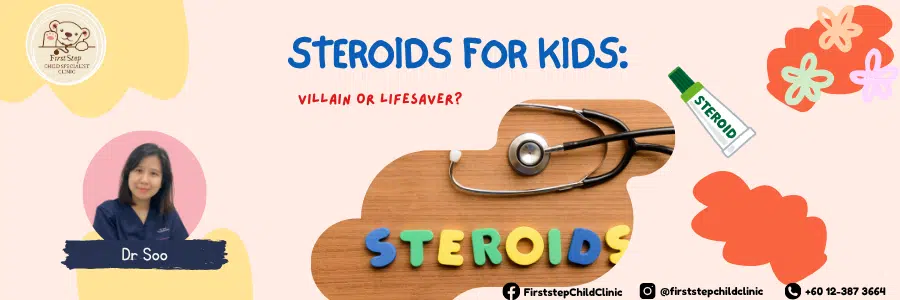
Steroids for Kids: Villain or Lifesaver?
Steroids for Kids: Villain or Lifesaver?
By Dr. Soo
When parents hear the word “steroids,” it often triggers an immediate sense of fear or skepticism. The mind may jump to scary headlines, side effects, or athletes caught in doping scandals. However, in the medical world, steroids — specifically corticosteroids — are an essential group of medicines that can save lives when used correctly. The truth is, like many powerful tools in medicine, their value lies in how and why they are used.
This article will guide you through what steroids are, when they are used for children, their potential risks, and why the right medical guidance makes all the difference.
First Things First: What Are Steroids?
In medicine, “steroids” generally refer to corticosteroids, which are synthetic versions of hormones naturally produced by our adrenal glands (such as cortisol). They are completely different from anabolic steroids, the muscle-building drugs associated with sports scandals.
Corticosteroids are powerful anti-inflammatory and immune-suppressing agents. They work by calming an overactive immune system and reducing swelling, redness, and allergic reactions. This makes them valuable in treating a wide range of conditions in children, from asthma flare-ups to severe allergic reactions.
When Are Steroids Used for Children?
Steroids are not prescribed casually. In pediatrics, they are reserved for specific conditions where the benefits outweigh the risks. Some common situations include:
1. Asthma Attacks
For children with asthma, inflammation in the airways can cause dangerous breathing difficulties. In such cases, oral or inhaled corticosteroids can quickly reduce airway swelling and prevent hospitalisation — or even save a life.
2. Severe Allergic Reactions
Conditions such as anaphylaxis require urgent treatment with adrenaline, but steroids are often given alongside to help reduce ongoing inflammation and prevent recurrence.
3. Autoimmune Conditions
Diseases like juvenile idiopathic arthritis or lupus cause the immune system to attack the body’s own tissues. Steroids help control this self-destruction, protecting the child’s organs from long-term damage.
4. Croup
Croup, a viral infection that causes swelling in the airway, often improves significantly after a single dose of oral steroids, helping the child breathe more comfortably.
5. Certain Skin Conditions
Severe eczema or allergic skin rashes may require topical steroids to calm inflammation and relieve itching.
6. Brain and Spinal Cord Conditions
In cases of swelling around the brain or spinal cord due to injury, infection, or tumours, steroids can rapidly reduce pressure and prevent further damage.
Why the Bad Reputation?
The fear surrounding steroids often comes from two sources:
-
Confusion between medical corticosteroids and anabolic steroids used for performance enhancement.
-
Concerns about side effects — which are real, but depend heavily on dosage, duration, and type of steroid used.
It’s true: when misused, steroids can cause serious problems. But the same is true for antibiotics, painkillers, or even paracetamol. The key is understanding that in medicine, risk is weighed against benefit. In life-threatening situations, steroids are often the safest and most effective choice.
Short-Term vs. Long-Term Use: The Big Difference
One of the most important distinctions in steroid therapy is short-term versus long-term use.
-
Short-term use (a few days to a couple of weeks) is generally very safe, especially when supervised by a doctor. The aim here is to quickly bring a condition under control.
-
Long-term use (weeks to months or longer) may be necessary for chronic illnesses, but requires close monitoring to manage potential side effects.
Possible Side Effects in Children
It’s important for parents to be aware of side effects — not to fear them, but to recognise and manage them early.
Short-term side effects may include:
-
Increased appetite
-
Mood changes (more irritable or restless)
-
Stomach upset
-
Temporary increase in blood sugar
Long-term side effects (with prolonged high-dose use) may include:
-
Slowed growth (usually temporary and catches up once treatment stops)
-
Increased risk of infections
-
Weight gain and round face (“moon face”)
-
Thinning of the skin
-
Bone thinning (osteoporosis)
-
Eye problems (cataracts or glaucoma)
Again, these are most likely in children who require months or years of continuous treatment — not those who take steroids for a few days for asthma or croup.
How Doctors Minimise Risks
When I prescribe steroids for a child, doctors follow strict safety principles:
-
Use the lowest effective dose for the shortest necessary duration.
-
Choose the safest form — for example, inhaled steroids for asthma act directly on the lungs, so they have fewer body-wide side effects compared to oral tablets.
-
Monitor closely — growth, weight, blood pressure, and blood sugar may be checked regularly for long-term users.
-
Educate parents — so they know what to expect and when to seek help.
Myth-Busting: Common Misconceptions About Steroids in Kids
Myth 1: Steroids will stunt my child’s growth permanently.
Fact: Short-term steroid use will not affect growth. Long-term high doses may slow growth temporarily, but this usually improves after treatment ends.
Myth 2: All steroids are dangerous.
Fact: Corticosteroids save lives every day. The danger comes from unsupervised or unnecessary use.
Myth 3: Steroids are only for very sick children.
Fact: While they are often used in serious conditions, even mild conditions like croup can benefit from a short course of steroids.
Myth 4: Inhaled steroids for asthma are as harmful as oral steroids.
Fact: Inhaled steroids act mostly in the lungs, with minimal absorption into the bloodstream, making them much safer for long-term use.
The Takeaway Message for Parents
Steroids are neither purely a villain nor a miracle cure — they are a medical tool. In the right hands, they can be lifesaving, preventing long-term complications and improving a child’s quality of life. In the wrong hands, or when misused, they can cause harm.
Here’s some advice for every parent:
-
Always ask why your child needs steroids and how long the treatment will last.
-
Never stop long-term steroid treatment suddenly without medical advice — this can be dangerous.
-
Keep all follow-up appointments for monitoring.
-
Do not use leftover steroid medicines without your doctor’s guidance.
When prescribed thoughtfully and monitored carefully, steroids can be one of the safest and most effective medicines in a pediatrician’s toolkit.



